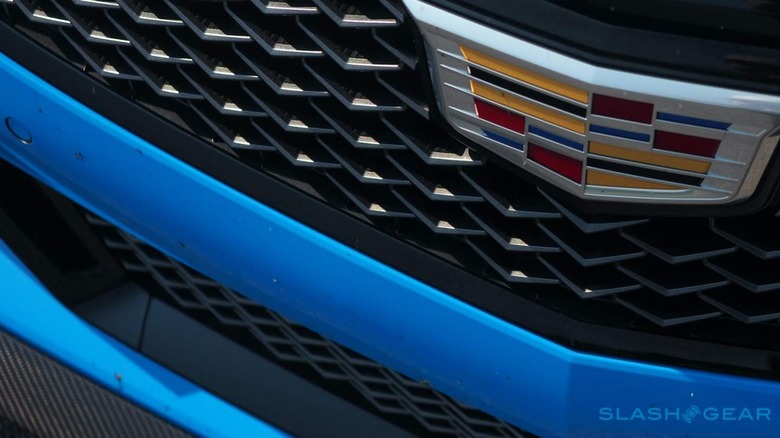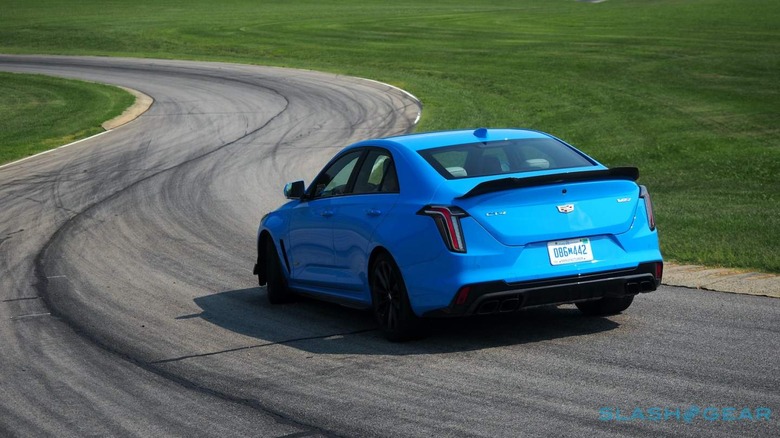2022 Cadillac CT4-V Blackwing First Drive Review: A Hero's Farewell
If you're bidding farewell to internal combustion, say goodbye with a bang. That's the recipe for the 2022 Cadillac CT4-V Blackwing, anyway, arriving just in time for the automaker to concede that gas engines have had their moment and electrification is the way forward. Question is, then, is today's Blackwing just tomorrow's dinosaur?
The answer, as you'd expect from anything as complex as a modern sports sedan, is a deeply complicated mixture of elevated engineering and baser instinct. The CT4-V Blackwing has to provide the visceral thrill that V-Series fans demand, but to deliver that in something worthy of a Cadillac badge.

Opt for the Carbon Fiber Package and it certainly looks the part. The various fins, vents, and spoilers are all 100-percent functional (and, you and your shins will be relieved to hear, all 100-percent in compliance with pedestrian safety rules) contributing to downforce as much as aesthetic. The CT4's vaguely Art Deco lights and crisp lines suit the Blackwing additions well, and the color options range from sober through to eye-grabbing metallic orange and punchy blue.

Keeping things interesting is a 3.6-liter twin-turbocharged V6, with 472 horsepower and 445 lb-ft of torque. It's a familiar engine, but the V-Series team has improved the air intake restriction, revised the ECM and control software, switched in low-inertia turbos, and – in the manual – added titanium connecting rods. The result is a more urgent torque response than the non-Blackwing car.

It'll do 0-60 mph in 3.9 seconds with the 10-speed automatic transmission, and rocket on to a 189 mph top speed. If you opt for the stick shift, it's a 6-speed Tremec with a close gear ratio, active rev-matching with a newly-located button so that it can be more easily activated regardless of the drive mode you're in, and a refined version of no-lift shift. 0-60 mph comes in 4.1 seconds, a reflection of the fact that computers are much better at some things than us humans, but a compromise I think worth making overall.
At a time when manual gearboxes are progressively vanishing, Cadillac's commitment to the option is a welcome surprise. Even so, the V-Series team is upfront that this really is the end of the line, and for more than just a stick. "We felt it was appropriate, being that these are the last gasoline V-Series sedans, that they have manual transmissions," Brandon Vivian, executive chief engineer at Cadillac, explains.

You can't accuse Cadillac of not listening to its most enthusiastic – and vocal – owners. The CT4-V Blackwing comes, as standard, with that six-speed manual and a starting price under $60k (admittedly before destination). It looks just as fast as it actually is, courtesy of a general sharpening and tightening of the already-eye-catching CT4-V's style.
The front and rear are new, though, and so are the new front fenders, helping accommodate the 20mm width increase for the Blackwing. What you won't find, though – at least officially – are wheels larger than the standard lightweight 18-inch alloys. That, the V-Series team says, is a very conscious decision.

For a start, these are not the same 18-inchers as on the non-Blackwing car. Instead, Cadillac has reshaped the interior profile of the wheel, and worked with brake partner Brembo to shave away some of the caliper housing, all in the name of fitting bigger rotors. The result is a 10mm disc size increase up-front.
The 14.96 x 1.34 inch rotors there are clamped down on by 6-piston calipers; at the rear, there are 4-piston calipers and 13.4 x 1.1 inch rotors. Gone is the old parking brake system, and in the process about a kilogram of weight. Cadillac replaced it with a second rear caliper.

Would 19-inch wheels fit in the arches? Sure, but these customized 18-inch versions are the largest that allow for sufficient sidewall for compliance, enough clearances in the wells for aggressive track maneuverers, plus contribute to weight reduction and, frankly, the affordability of new rubber. Cadillac definitely expects CT4-V Blackwing owners to take their cars to the track, and running costs are a legitimate consideration. You could put on bigger wheels yourself, engineering chief Brandon Vivian acknowledges, but "you're making a compromise that we won't make on the cars that we offer."
Spend any time talking to the V-Series team and you quickly get the impression that "compromise" is a particularly dirty word. With lingering suspicion around how much of a part electronics play from some quarters, it's little surprise that finessing their involvement was another area of focus. "It's not just the chassis, the fundamentals," Vivian says, "it's how the electronics are integrated into that."

Magnetic Ride Control 4.0 is standard, now using accelerometers on each wheel for swifter adjustments to the dampers. There are the usual Tour, Sport, Snow/Ice, and Track drive modes, but they're joined by My Mode and V-Mode options too. The former is customizable for everyday driving, allowing tweaks to steering feel, brake response, suspension, and engine sound; it remains active even after you restart the car.
V-Mode, meanwhile, gets a dedicated button on the steering wheel, for summoning your pick of the sporting settings. Along with the My Mode adjustments, there's control over powertrain and Performance Traction Management (PTM) configuration, the latter now having five different modes of its own. Opt for the Performance Steering Wheel and there's a dedicated PTM mode switch on there, too.

The irony is that, for all Cadillac's clear consideration here, the CT4-V Blackwing is compelling in no small part because all of that gets out of your way. Hit the V-Mode button and it's just ready for some fun; flick over to Tour mode, and you're back in a sedan that's very nearly as soft and cosseting as a regular CT4. The switchgear feels solid, the infotainment – with wireless Apple CarPlay and Android Auto – is straightforward to use, and the sports seats are beautifully finished and supportive.
Out on the road, that duality made itself obvious. You can swish in supple relaxation around sweeping roads, or cruise highways, but then stab a button and wake the Blackwing beast underneath. The automatic feels the most "Cadillac" but the beautifully weighted manual is too good to skip. Everything from the length of the throw and the feel of the shifter in your palm, to the heft of the clutch and the way the engine blips as you downshift, all underscore that enthusiast mindset.

The realization around just how much those enthusiasts shaped this car is doubly-clear on the track. Virginia International Raceway's Full Course is 3.27 miles of deceptive twists and elevation changes seemingly designed to upset the over-eager driver. While there may be long straights ideal to stretch your legs, the sudden corners right behind them mean there's little time to settle back and watch the speedo digits climb.
If there's a word to describe the CT4-V Blackwing, it's probably "accessible": the sports sedan epitomizes balance. Power isn't lacking, of course, even if you don't have the tumultuous excesses of the CT5-V Blackwing and its beastly V8. However you also don't get that car's weight, and the smaller model wields its V6 particularly well.
Some cars seem determined to terrify, and some just want to have fun. The CT4-V Blackwing falls into the latter category, point-and-squirt fast when you want it, but sublimely grippy when it comes time to haul the wheel. I'm a mediocre track driver, frankly, but the Cadillac flatters and encourages.

The beefy brakes help, too, as does the general resilience of what the automaker has put together. With temperatures in the mid to high 90s, it wouldn't be unfair to expect stopping power to fade and engines to overheat. Instead, the Blackwing delivered no noticeable fade, no dip in the cabin A/C, and even the seat coolers kept doing their part. I suspect you'll tire before the Caddy does.
There's technical magic going on in the background, of course. While you can dial back the traction control in the PTM system's top two settings, until it'll only kick in should you over-cook things on exiting a corner, the lower modes are much more user-friendly. They're communicative, too, the sounds of the various systems contributing their respective expertise providing a non-verbal reminder of where you might want to tighten up your game on the next lap.

In fact there's a lot about the Blackwing that feels as much a tutor as a plaything. The second-generation Performance Data Recorder (PDR 2.0) now captures 1080p Full HD video from the front-facing camera and can optionally pair it with cabin audio. In the background, it's also recording up to 34 channels of vehicle metrics, from steering angle and throttle position, to G-forces and PTM mode. The result can be as simple and entertaining as a video of your lap, to as educational as loading the file in the Cosworth Toolbox app and seeing exactly what you did and where you did it on the track.

It would be, quite honestly, a crying shame if you bought a CT4-V Blackwing and only drove it on the road. Sure, it has the manners for that, but the extent of Cadillac's handiwork here only becomes truly visible when you're pushing hard. Harder, certainly, than is either legal or advisable on public roads.
Best of all, though the sedan may be a limited edition, it's not some unobtainable exotic. Pricing kicks off at $59,990 (plus $995 destination) with that lovely manual; you'll pay $63,165 for the 10-speed automatic. Even a fully-loaded car is around $85k.

Like a lot of people, I found myself wondering why Cadillac really bothered with the CT4-V Blackwing when it announced the two Blackwing models. The CT5-based car is more powerful, faster, and more luxurious, after all: if you're going for excess, why stop partway?
The reality, it turns out, is that balance is more important than excess. "The goal of this car was to make this the best driving car we've ever made," Cadillac's Vivian says, not necessarily the quickest or the most potent. It's a timely reminder, too, that though electrification may be a shortcut to more horsepower, it takes more than that to make a great driver's car. As gauntlets thrown down go, then, the CT4-V Blackwing sets an unexpectedly high bar for the future of the V-Series.
